September 2013
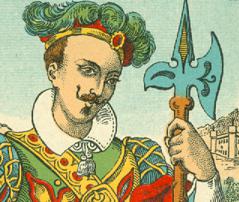 |
Most of
September was spend on our well-deserved vacation and before and after
we were too busy to really follow the offer on Ebay and our local
Marktplaats. So we had to choose from what we had picked up along
the way and at the IPCS convention, which also served as the
closing of our vacation. We had started with 3 nights in Paris, but the
local fleamarkets at the Porte de Vanves and Clignancourt didn't bring
any decks for our own collection, just some nice trading material.
During our week in Hyères at the Côte d'Azur there was one local
fleamarket there and it brought us one new deck and several ones for
trading. During one of our trips in the local region we picked up
another new one for us at a Brocante shop, but that was it. |

|
|
And also
later in Annecy, Geneva (at a Wednesday fleamarket on a main square) or
Aix-les-Bains no decks turned up. So the trading sessions during the
IPCS convention in La Tour de Peilz (near Montreux, Switzerland) had to
bring something good and within the first 15 minutes there....... they
did! |
It's not a new
deck, but an improvement of the quality. Several years ago we were very happy to
buy this deck on Ebay. It was one of the few decks from the Albert Field
collection that were ever auctioned on Ebay. It was in very good but used
condition and we considered it as a great addition for our Speelkaartenfabriek
Nederland sub-collection. Nobody seems to realize how scarce this deck is. Only
2 or 3 Dutch collectors have it in their collection and we hadn't seen one
during our first 10 years of collecting until Albert Field's copy turned up.
At the IPCS convention a Belgian collector was selling a number of decks from
the renowned collection of the late Robert van Gool. Among them was this deck
and it was in perfect, almost mint condition, with shiny gold corners. It was
offered at a bargain price, so it took only a split second to decide on the buy
and we didn't even want to haggle.
Back home it was easily decided that Albert's was out and Robert's was in and
that this would be a good moment to share this colorful deck with a larger
audience. So here's our Deck of the Month......
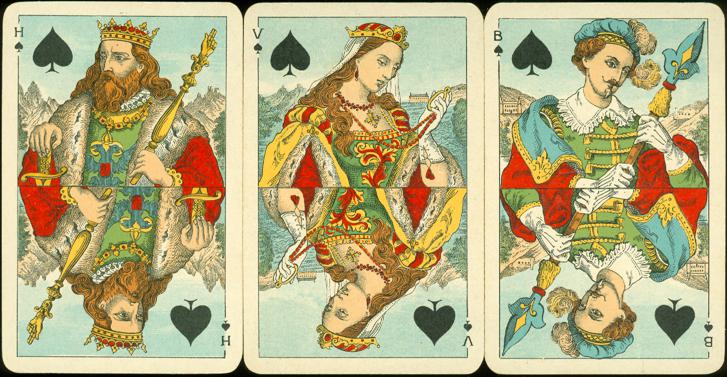
The deck was made
by the Nederlandsche Speelkaarten Fabriek (NSF) from Amsterdam, Netherlands,
which went bankrupt and was continued as the Speelkaartenfabriek Nederland (SN)
in 1912. It was among the first decks that the NSF began producing and
publishing. The name of the deck, "Rhenania", was deposited in 1910,
but the deck was first published in 1911.
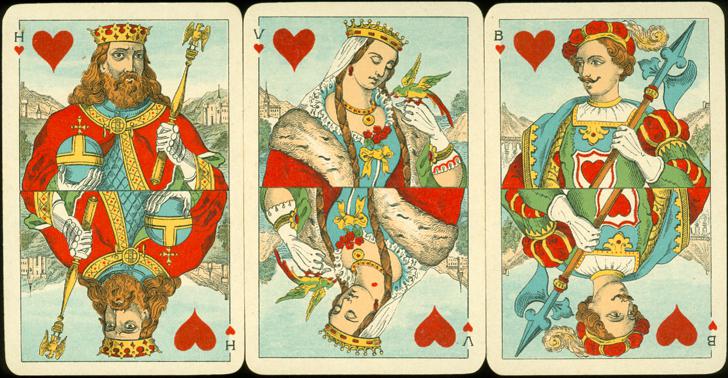
There is a
striking resemblance between the designs of the courts in this deck and those in
the "Cartes Impériales" decks that were manufactured in Turnhout,
Belgium, by A. van Genechten and Brepols & Dierckx. The Belgian decks were
already on the market (since around 1875) when NSF published their almost exact
copy. It's hard to guess why the young company went for this portrait. Maybe it
was intended to show that the NSF could produce decks of an equally high quality
as the makers from Turnhout. In which case their target was reached, without any
doubt. But it could also be that NSF wanted to introduce a standard pattern for
the Netherlands at a mid-range price, between the luxurious Neerlandia and the
cheaper -for common use- Kroon cards.
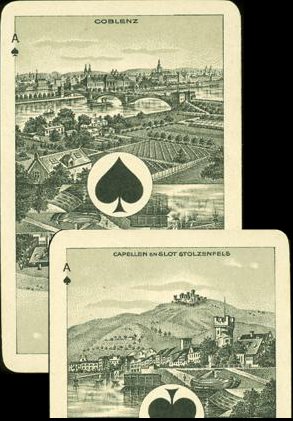


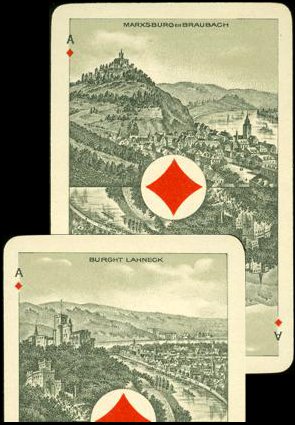
However, the set of accompanying aces is unique. They were
only issued with this deck and show scenes of cities, towns, fortresses, castles
and ruins of them along the river Rhine in Germany. Hence the name "Rhenania"
for the deck. The captions are in Dutch though, so the deck was probably not
intended for export, but for the local Dutch market. This is supported by the
use of Dutch indices on the court cards.

Typical for this deck and also for the Belgian Cartes
Impériales are the colored designs of the background. There are differences to
be found there between the NSF version and the Belgian ones, although the
general concept is the same on both. The NSF version is easier recognized by the
color of the indices. In both red suits the indices are printed in black. A
feature that NSF has used in other decks too.
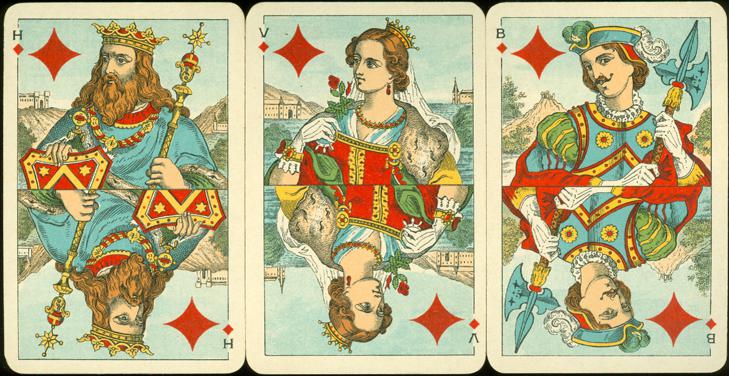
|
Rhenania
was published as a 32 cards deck and as a 52 cards deck. Sometimes an
extra card, which mentioned the other published decks by NSF, was added
to the 32 cards version.
Because SN had bought the stock of playing cards from the NSF when it
continued their business, the Rhenania deck was mentioned in the first SN
sample book from around 1913.
The deck
is probably so scarce, because SN has most likely never produced this
deck any further, and has only disposed of the old NSF stock.
In 1914 the Great War (WW I) began and although the Netherlands were officially
impartial, there was already some resentment against the German emperor and his
policies. The set of German aces would probably not have gone down well
with the general public.
It's only certain that the deck hasn't been in production for long. |
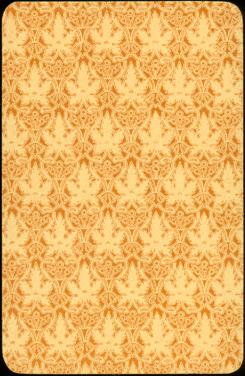
|
|
The backs
show a wallpaper-like design with a repeated leave. This design is also
known in a blue version. |
|
Our 32 cards
deck came without a box or extra card, but our first deck didn't have
those either. Still we're very content that we could improve the quality
of our collection just a bit further. |
BACK TO PRESENT MONTH










